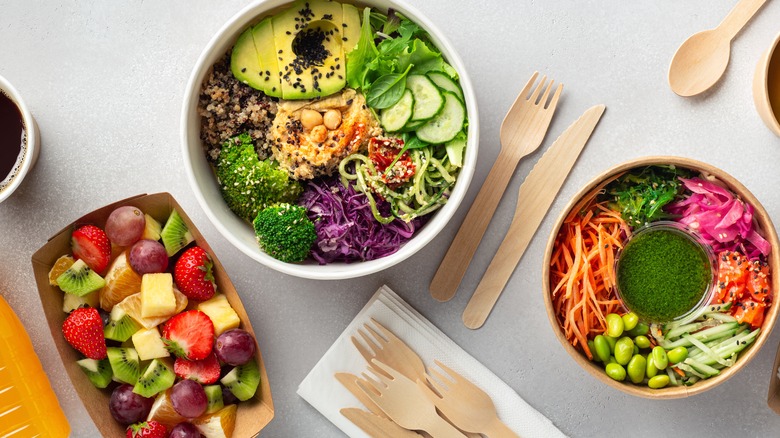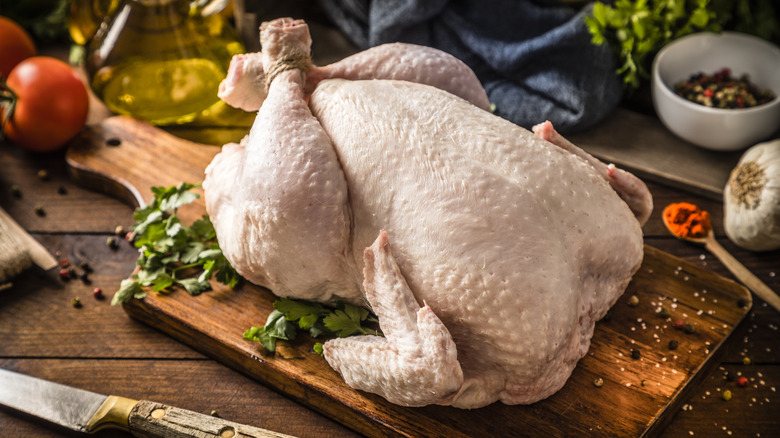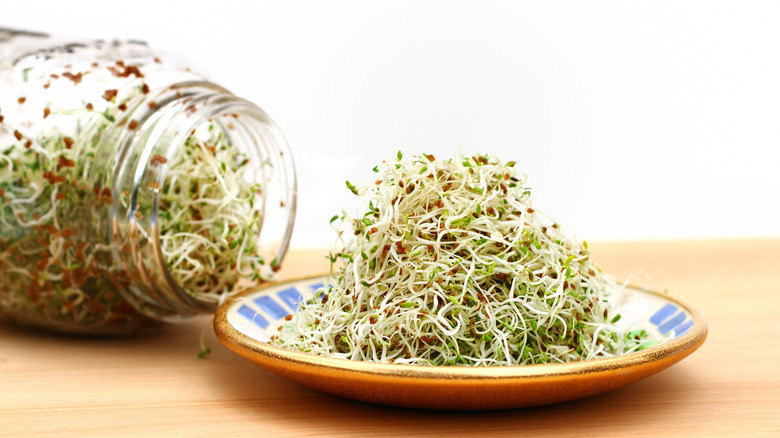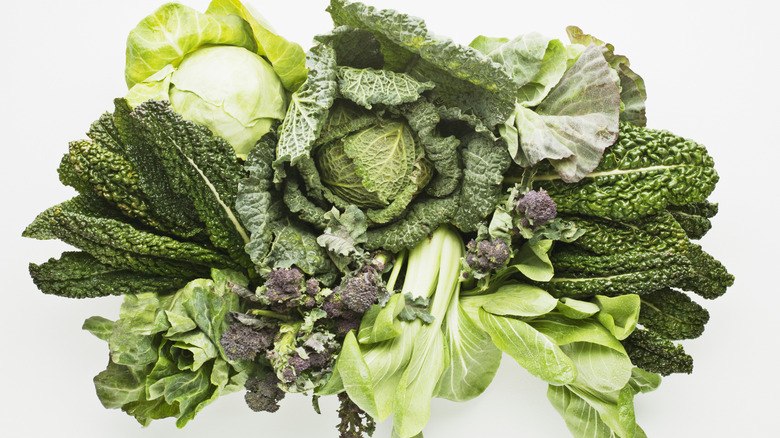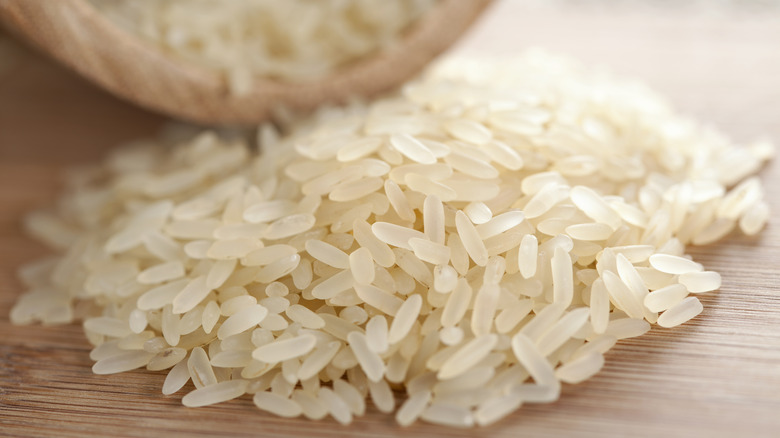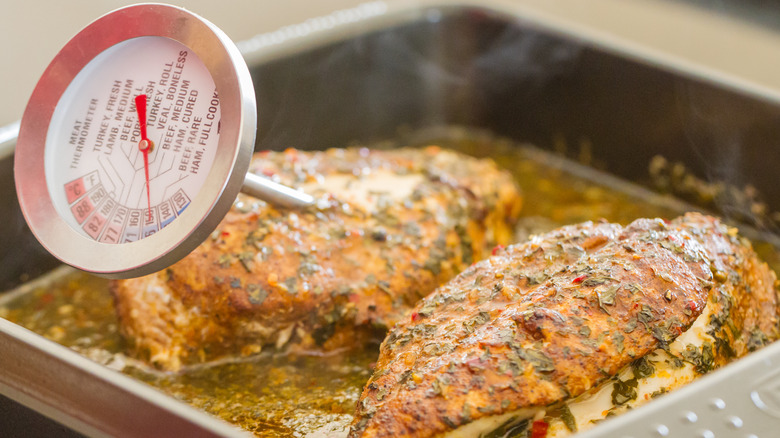These 12 Foods Are Most Likely To Give You Food Poisoning
Food poisoning can swiftly turn a delightful dining experience into a nightmarish ordeal. According to the Mayo Clinic, it is the unfortunate outcome of consuming contaminated food or beverages by harmful microorganisms (pathogens), including bacteria, viruses, parasites, poisonous toxins, and molds that produce said toxins. Food can become contaminated at many points during its journey from farm to table, including during cultivation, harvesting, processing, storage, shipping, or even the preparation of food at home due to improper food handling practices such as inadequate handwashing, neglected disinfection of cooking and eating areas, and improper storage, all of which promote pathogen growth.
Per the Centers for Disease Control and Prevention (CDC), symptoms of food poisoning can range from mild discomfort to severe distress, with manifestations including diarrhea, nausea, vomiting, stomach cramps, and fever. The onset of these symptoms can vary depending on the contaminant, as some pathogens act swiftly within hours of consumption. In contrast, others may take days to incapacitate their hosts. Additionally, the CDC states that specific individuals have a higher risk of developing a foodborne illness, including those aged 65 and older, young children, pregnant women, and those with weakened immune systems due to specific medical conditions. In these vulnerable populations, the body's natural defenses are compromised, making them less able to defend themselves against harmful germs. This article explores foods that are most likely to cause food poisoning, unraveling the culprits that can turn your meals into a painful experience and offering tips on how to prevent it.
Raw or pre-cut fruits and vegetables
Eating raw or pre-cut fruits and vegetables can be a double-edged sword in the realm of nutrition. While they are packed with essential nutrients that boost your health, they also harbor potential risks that can make you ill. According to the CDC, raw produce, like fruits and vegetables, can sometimes carry harmful bacteria such as Salmonella, E. coli, and Listeria.
Per the U.S. Food and Drug Administration (FDA), the inherent risk of consuming raw or pre-cut produce stems from how they are processed and handled. When fresh produce undergoes processing without proper sanitation measures, the potential for contamination by harmful microorganisms increases significantly. Furthermore, converting fresh fruits and vegetables into pre-cut products involves breaking the natural protective barrier on their surfaces, making them susceptible to bacterial growth and contamination. When these fruits and vegetables are cut or shredded, they release plant cellular fluids that provide the perfect environment for any microorganisms present to survive and proliferate. Moreover, this risk is amplified by the high moisture and nutrient content of fresh-cut produce, the absence of a pathogen-eliminating step like heat during production, and the possibility of temperature mishandling during processing, storage, transportation, and retail display.
Per the CDC, you may reduce this risk by opting for produce that is undamaged and unbruised, choosing refrigerated or ice-stored pre-cut items, keeping fruits and vegetables separate from raw meats and seafood during shopping and storage, and always washing them thoroughly before consumption.
Raw or undercooked chicken
According to the CDC, consuming raw or undercooked chicken presents a significant risk of food poisoning due to potential contamination by harmful bacteria, primarily Campylobacter, Salmonella, and Clostridium perfringens. Notably, Salmonella is a major culprit, causing more foodborne illnesses than any other bacteria, with chicken being a significant source of these infections. Moreover, the danger can extend beyond the chicken itself, as contamination can spread to other foods and beverages if they come into contact with raw chicken or its juices, especially those meant to be consumed raw, like fruits or salads.
Per Medical News Today (MNT), bacteria in chicken can lead to symptoms such as diarrhea, fever, stomach cramps, nausea, vomiting, and headaches, which usually go away on their own without needing a doctor. Still, it's important to drink plenty of water, especially if you're vomiting or having diarrhea. Regarding the guidelines to protect yourself from chicken-induced food poisoning, registered dietitian Mia DiGeronimo, RD., explains (via the Cleveland Clinic) that it's crucial to cook chicken to an internal temperature of 165 degrees Fahrenheit to kill harmful bacteria. Plus, try to refrigerate raw chicken in its original packaging on the bottom shelf of the refrigerator for a maximum of two days, or freeze it if you want to store it for longer. Lastly, per the CDC, contrary to common belief, raw chicken should not be washed before cooking, as this practice can spread bacteria onto your kitchen sink and adjacent surfaces.
Raw or undercooked meats
Despite raw meat dishes like steak tartare, carpaccio, mett, and Pittsburgh rare steak being popular restaurant menu items, you should still be aware that consuming raw or undercooked meats, such as beef or pork, carries a substantial risk of food poisoning. According to Healthline, while some tout the nutritional superiority of raw meat, there's limited evidence to support this claim, and evidence shows that cooking meat not only renders it more palatable but also breaks down proteins for easier digestion and increases the availability of certain minerals like copper, zinc, and iron.
Eating raw or undercooked meats like beef and pork can expose you to potential contamination by microorganisms such as E. coli and Trichinella roundworms, respectively. In fact, according to Insider, in a recent incident in 2022, six people required hospitalization due to E. coli infection after consuming contaminated ground beef from a meal delivery service. Moreover, the Cleveland Clinic explains that trichinosis, a parasitic foodborne disease from eating contaminated pork products, can lead to a myriad of symptoms that can vary in severity. Mild and early manifestations include nausea, vomiting, diarrhea, and abdominal pain. In contrast, moderate and severe symptoms may range from muscle soreness, fever, and headaches to heart muscle inflammation, breathing problems, and brain inflammation. To steer clear of these food poisoning risks, cook beef and pork to an internal temperature of at least 160 degrees Fahrenheit, which is sufficiently high to eliminate most harmful bacteria.
Unpasteurized (raw) milk and derived products
According to the CDC, consuming unpasteurized (raw) milk and its derived products (aka soft cheeses, ice cream, and yogurt made from raw milk) can significantly boost the risk of food poisoning. In fact, raw milk is connected to multiple preventable food poisoning outbreaks per year, earning its reputation as one of the riskiest foods. Raw milk refers to milk that has not undergone pasteurization, a process that requires milk to be subjected to high temperatures and is designed to eliminate harmful germs in the milk. Thus, by forgoing said heating, raw milk may potentially contain bacteria such as Campylobacter, Cryptosporidium, E. coli, Listeria, Brucella, and Salmonella, as well as viruses and parasites.
Raw milk-induced food poisoning may last several days and include symptoms like diarrhea, stomach cramps, and vomiting. In more severe cases, people may develop life-threatening conditions such as Guillain-Barré syndrome, leading to paralysis, or hemolytic uremic syndrome, which can result in kidney failure, stroke, and even death. Raw milk contamination can occur through various pathways, including germs originating from the cow's feces, skin, or surroundings, udder infections (mastitis), diseases like tuberculosis, insects, rodents, or other small animals that may reach the milk. Additionally, poor hygiene in milk plants and worker cross-contamination heighten the risk.
To reduce the risks associated with raw milk, the CDC recommends buying pasteurized milk and dairy products, storing milk and dairy items in the fridge at or below 40 degrees Fahrenheit, and discarding expired milk and dairy products.
Raw or undercooked (runny) eggs
Consuming raw or undercooked (runny) eggs can significantly increase the risk of food poisoning due to the potential presence of Salmonella bacteria. The CDC explains that since chickens can carry the bacteria, it can easily spread from the birds to their eggs. One of the main routes of contamination is by infecting the eggshells during laying, especially if they come into contact with bird droppings. This means you may contaminate the eggs once you crack them and potentially consume the bacteria if the egg is not thoroughly cooked.
Additionally, bacteria can also penetrate the inside of eggs during the formation process before the shell is developed. Thus, according to the FDA, even seemingly fresh eggs with clean, uncracked shells may harbor Salmonella. Symptoms of Salmonella infection may appear up to 72 hours after consumption (making it hard to pinpoint what exactly led to the poisoning) and include diarrhea, fever, abdominal cramps, and vomiting, which may last anywhere from 4 to 7 days.
To minimize the risk of getting sick from eggs, the CDC shares some preventive measures, such as purchasing eggs from stores and suppliers that refrigerate them and refrigerating them at 40 degrees Fahrenheit or colder at home, discarding cracked eggs, and cooking them thoroughly. You may also consider opting for pasteurized eggs and egg products, especially when preparing foods containing raw or lightly cooked eggs like aioli, homemade mayo, or Hollandaise sauce. Lastly, avoiding tasting or consuming raw dough or batter made with raw eggs, such as cookie dough or cake batter, is crucial to preventing potential exposure.
Raw or undercooked fish
Indulging in raw fish dishes like sushi, ceviche, poke, carpaccio, and gravlax, popular in various culinary traditions around the world, can expose you to a potential risk of food poisoning and parasitic infections. According to Healthline, consuming undercooked or raw fish may lead to the transmission of various parasitic diseases that can lead to a range of health issues. Said diseases include opisthorchiasis, fish tapeworm infections, and anisakiasis. The first is a condition caused by parasitic flatworms known as liver flukes, while the second is typically transmitted through freshwater fish or sea fish that reproduce in freshwater rivers. In contrast, the third is a disease originating from parasitic roundworms settled in marine fish or fish transitioning between freshwater and sea habitats.
In addition to parasitic threats, Healthline explains that raw fish can also harbor harmful bacteria such as Listeria, Vibrio, Clostridium, and Salmonella, which are known to cause foodborne illnesses with symptoms like diarrhea, abdominal cramps, nausea, and vomiting. Additionally, raw fish may contain elevated levels of toxic pollutants, as fish are known to accumulate these chemicals over time. To savor the delights of raw fish while minimizing health risks, it's crucial to be cautious and opt for high-quality, trusted seafood sources. Otherwise, the CDC recommends cooking fish to an internal temperature of at least 145 degrees Fahrenheit or until you can easily separate the opaque flesh with a fork.
Oysters
Consuming raw or undercooked oysters presents a significant risk of food poisoning, particularly from vibriosis, caused by Vibrio bacteria commonly found in coastal waters where oysters reside. As explained by the CDC, since oysters filter water to feed, they can gather high amounts of Vibrio in their tissues, making them potential carriers of illness. Plus, contrary to popular belief, you can't tell an infected oyster from a healthy one based on appearance, smell, or taste. Vibriosis can occur throughout the year, but it peaks from May to October when warmer water temperatures facilitate bacterial growth. While most vibrio infections result in mild symptoms like diarrhea and vomiting, vibrio vulnificus infections, although rare, can be severe, causing severe complications that may result in death.
Additionally, per New Health Advisor, oysters can also harbor norovirus, which leads to symptoms like watery diarrhea, nausea, vomiting, and abdominal cramps within 10 to 48 hours of exposure. To prevent vibriosis or norovirus infection, cook oysters and seafood thoroughly. For example, shucked oysters should be boiled for at least 3 minutes or fried at 375 degrees Fahrenheit for 11 minutes. When boiling or steaming whole oysters, continue cooking for 5 and 10 minutes, respectively, after the shells open, and discard those that don't open while cooking, as this indicates they might be unsafe to consume. Also, remember to separate cooked seafood from raw products and their juices. Lastly, avoid saltwater or brackish water if you have wounds to minimize the risk of infection.
Flour
Believe it or not, flour is considered a raw food. Thus, this seemingly innocuous ingredient can lead to food poisoning if you don't handle it with care. According to the FDA, flour is a raw food because it is made from raw grains grown in fields, and since the milling of the grains does not require heat or sterilization during processing, it leaves them susceptible to contamination from harmful microorganisms like Salmonella and E. coli that can easily end up in your favorite brand of flour. While both bacteria in flour are killed when cooked or baked, the risk arises when people consume or taste foods containing raw flour, including raw dough used for crafts and play clay. In fact, there have been multiple food poisoning outbreaks related to raw flour intake from cake and cookie batter since 2009.
To ensure safety, it is imperative to thoroughly cook foods made with flour. Per CNN Health, the CDC advises adhering to recipe or package guidelines to ensure thoroughly cooking baked goods containing raw flour. Additionally, practicing good hygiene is crucial, involving washing hands, utensils, countertops, and any surface that touches raw flour with warm water and soap to prevent cross-contamination. Finally, even when making homemade playdough, it's recommended to use heat-treated flour for safety. By adhering to these guidelines and understanding the potential dangers of raw flour, you may enjoy delicious baked goods and creative activities without compromising your health and well-being.
Sprouts
While sprouts like alfalfa, mung bean, onion, radish, mustard, and broccoli are nutritional powerhouses, consuming them can pose a significant risk of food poisoning. As the Government of Canada explains, these tiny greens can easily come into contact with harmful bacteria during various stages of production, including farming, packaging, storage, transportation, and preparation, through cross-contamination. Plus, the FDA adds that bacteria can infiltrate sprout seeds through cracks in the shell, making it nearly impossible to eliminate them once contaminated. Lastly, Healthline clarifies that the reason bacteria thrive in sprouts is because sprouts are cultivated in warm, humid conditions, which are ideal environments for the growth of harmful bacteria like E. coli and Salmonella, leading to food poisoning symptoms such as diarrhea, stomach cramps, and vomiting, which can show up even 72 hours after consuming contaminated sprouts.
The FDA shares several precautions to minimize the risk of foodborne illnesses associated with sprouts. Firstly, it is essential to avoid consuming raw sprouts of any kind. Secondly, thoroughly cooking sprouts before consumption can significantly reduce the risk. Additionally, when dining out, ask for raw sprouts to be removed from sandwiches and salads. Lastly, the Canadian government suggests only purchasing refrigerated sprouts that appear crisp. Once bought, refrigerate the sprouts promptly to maintain freshness and minimize the risk of bacterial growth.
Leafy greens
Leafy greens, including lettuce, spinach, cabbage, kale, and bok choy, are rich in nutrients that fortify the body against various diseases. However, their raw nature poses a potential risk of food poisoning, and, to make matters worse, washing these greens may not eliminate all germs as they can cling to the leaves' surface or even infiltrate them (via the CDC). Per the site, contamination can occur at any point, from the growing and harvesting stages to your kitchen, and it affects both conventional and organic leafy greens alike. According to MNT, norovirus is a common culprit behind leafy greens-related illnesses. However, notable outbreaks, such as the 2021 recall of packaged salads in the U.S., also point to listeria as a potential contaminator (via Insider).
Seeing that leafy greens are a vital part of a healthy diet, the CDC shares a number of tips for minimizing the risk of foodborne illness. For instance, a thorough rinse under running water is the best method to sanitize unwashed greens instead of soaking them, which can lead to the spread of germs. In contrast, prewashed greens typically don't require additional washing. Moreover, discarding torn or bruised leaves and outer layers of cabbages and lettuce heads is a must. Lastly, it is best to store leafy greens and pre-made salads in a clean refrigerator set to 40 degrees Fahrenheit or colder.
Rice
Rice can potentially be a source of food poisoning, particularly due to the presence of Bacillus cereus (B. cereus), a spore-forming, toxin-producing bacteria that can be present in uncooked rice and remain even after cooking (via the NHS). Per Medline Plus, spores are thick-walled cells that some fungi and bacteria use for reproduction, and they can resist environmental conditions such as high temperatures that usually get other microorganisms killed. In fact, according to an older study published in the journal Epidemiology and Infection, the spores of B. cereus have remarkable resilience. These bacteria reportedly thrive at temperatures ranging from 86 to 98 degrees Fahrenheit, and they can also grow during storage at 59 to 109 degrees Fahrenheit.
To minimize the risk of B. cereus-related food poisoning, keep the rice hot (at a temperature above 145 degrees Fahrenheit) after cooking, or cool it rapidly and transfer it to a refrigerator within two hours of cooking. This is because when cooked rice is left at room temperature, the spores can germinate, leading to bacterial growth and potential toxin production (per the NHS).
Eating contaminated rice can result in symptoms such as vomiting within 30 minutes to 6 hours after consumption or diarrhea occurring 6 to 15 hours later. Fortunately, the symptoms are generally mild and short-lived, typically lasting around 24 hours. To enjoy rice while mitigating the risk of food poisoning, make sure your rice is steaming hot all the way through when reheated, and try to only reheat it once.
Deli meats
Consuming deli meats, including cold cuts, lunch meats, hot dogs, and patés, can increase the risk of food poisoning due to the presence of listeria, a resistant bacteria that spreads easily among food and common deli surfaces (via the CDC). Listeria is particularly concerning because it can endure in typical deli environments, even surviving in cold temperatures within refrigerators. And once present, the bacteria is challenging to eliminate.
This germ can lead to a disease called listeriosis, with symptoms appearing within two weeks after consuming contaminated food, although they can manifest as early as the same day or as late as 10 weeks afterward. To minimize the risk, the FDA urges people to handle deli meats with care. Recommended food safety measures include ensuring that deli meats are properly refrigerated at 40 degrees Fahrenheit, consuming them as soon as possible to keep listeria from growing, and regularly cleaning the inside of the fridge with hot water and soap.
How to prevent food poisoning
Ensuring food safety is paramount to preventing food poisoning. Therefore, the CDC shares four fundamental steps to significantly reduce the risk of contamination. The first step (aka the cleaning step) encourages you to wash your hands thoroughly before, during, and after handling food, and also clean utensils, cutting boards, and countertops with hot, soapy water after each food item preparation to prevent the spread of harmful germs. The second step is the separation step, which aims to avoid cross-contamination by separating raw meats, poultry, and seafood from ready-to-eat foods. It also suggests using different cutting boards or plates for each category to keep food juices from reaching items that won't be heated.
The third (cooking) step emphasizes the importance of food reaching safe internal temperatures while cooking. Beef, veal, lamb, and pork should reach 145 degrees Fahrenheit; fish with fins should be cooked until the flesh is opaque; ground meats should reach 160 degrees Fahrenheit; and all poultry should reach 165 degrees Fahrenheit. When reheating, your food should reach 165 degrees Fahrenheit. Lastly, the fourth step concerns the way you chill your food. To keep germs from growing while at room temperature (aka the "Danger Zone," between 40 and 140 degrees Fahrenheit), avoid keeping perishable foods on your counters for more than two hours.
Finally, the CDC also recommends thawing foods safely in the fridge, cold water, or microwave and washing all fruits and vegetables under running water, even those you plan to peel.


